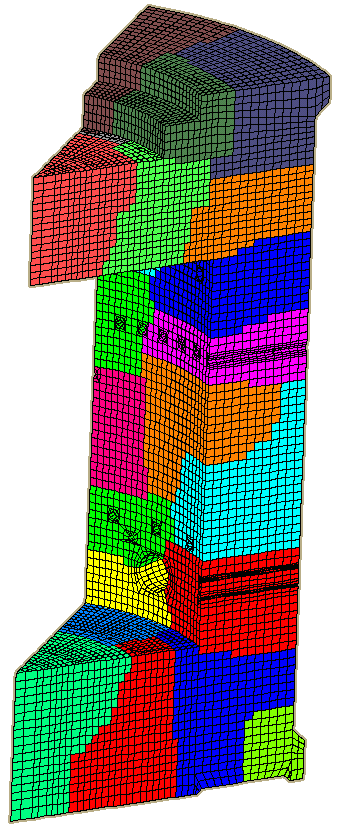 SIFEL Home page
SIFEL Home page
SIFEL - SImple Finite ELements
HPMESHDECOMP
The HPMESHDECOMP is an open source project for decomposition of meshes, which will be used in parallel computing for homogenization using two-level approach. The HPMESHDECOMP code is a part of SIFEL open source project and is located in PREP/HPARTITIONING/ of SIFEL folder sturcture. The code uses keywords from SIFEL. The HPMESHDECOMP comes out from MESHDECOMP. It takes over all features of MESHDECOMP, and moreover, it creates aggregates of elements respecting material interfaces. HPMESHDECOMP requires MESHDECOMP installation in PREP/PARTITIONING/ folder.
The syntax example for usage is:
./hpmeshdecomp brick_makro.dec
brick_makro.dec is a file with informations about mesh and decomposition of macro problem (at macro level). For the detailed, the same, syntax, see MESHDECOMP.
Example of file brick_makro.dec in case of all:
begsec_files
#mesh description (commented)
topology_file brick_makro.top
mesh_format sifel
#mesh_description bound_nodes (commented)
edge_numbering 1
endsec_files
begsec_part
processing all
mesh_description bound_nodes
number_of_partitions 25
weight_graph noweight
output_file_name brick_makro_p.top
partitioning_technique recursive
endsec_part
brick_makro_p1.top - brick_makro_p25.top. Moreover, subdomains will be split according to material types and the aggregates for macro level will be created. The number of aggregates can increase against the number of domains. In this case, 30 aggregates will be created. The list of aggregates will be stored into brick_makro_p.hom.mat file. This whole text file must be added into the input file brick1.in, which is intended for master processor in processor farming method.
In case of homogenization with processor farming method input files of SEPUCs (statistically equivalent periodic unit cells) must be created, e.g., SEPUC1 for brick and fillings, and SEPUC2 for mortar.
Written by Tomas Krejci 2018-02-01 accrding to Jaroslav Broz 2010-11-11
